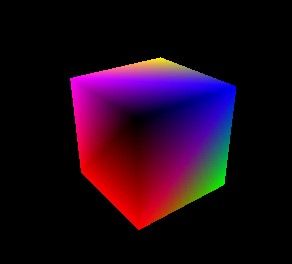android opengl es 立方体
绘制立方体的原理很简单了,就是通过绘制三角形而来的,当然还可以通过绘制线来完成。

下面是核心代码:
public class CubeRender implements Renderer {
Cube cb;
float ratio;
@Override
public void onDrawFrame(GL10 gl) {
// TODO Auto-generated method stub
gl.glClear(GL10.GL_COLOR_BUFFER_BIT|GL10.GL_DEPTH_BUFFER_BIT);
gl.glMatrixMode(GL10.GL_MODELVIEW);
gl.glLoadIdentity();
gl.glTranslatef(0, 0, -5);
cb.drawSelf(gl);
// tgl.drawSelf(gl);
}
@Override
public void onSurfaceChanged(GL10 gl, int width, int height) {
// TODO Auto-generated method stub
gl.glViewport(0, 0, width, height);
gl.glMatrixMode(GL10.GL_PROJECTION);
gl.glLoadIdentity();
gl.glShadeModel(GL10.GL_SMOOTH);
ratio=(float)width/height;
gl.glFrustumf(-ratio,ratio, -1, 1, 1,10);
cb=new Cube(0,0,0,2,ratio);
}
@Override
public void onSurfaceCreated(GL10 gl, EGLConfig config) {
gl.glClearColor(0, 0, 0, 0);
gl.glEnable(GL10.GL_DEPTH_TEST);
}
}
大家可以看到Cube的构造函数中,最后一个参数为 屏幕的 宽高比,
这是因为 我使用的是平板,宽高并不是1:1,画出来的立方体 高度有点短,为了对此进行修复,
将宽高比传入进去,在计算坐标的时候 只需要将高度乘以ratio即可。
下面是Cube(立方体的代码)
public class Cube {
private int one=50000;
private int cone=65535;
private int icont;
private IntBuffer pointBuffer;
private IntBuffer colorBuffer;
private ByteBuffer indexBuffer;
private int rotateX;
private int rotateY;
private int rotateZ;
public Cube(int centerX,int centerY,int centerZ,int sideLen,float ratio)
{
int leftX=centerX-sideLen/2;
int rightX=centerX+sideLen/2;
int bottomY=centerY-(int)(sideLen/2*ratio);//*ratio 对高度 进行修复
int topY=centerY+(int)(sideLen/2*ratio);//*ratio 对高度 进行修复
int outZ=centerZ+sideLen/2;
int inZ=centerZ-sideLen/2;
int[] points=new int[]{
leftX*one,bottomY*one,outZ*one,
rightX*one,bottomY*one,outZ*one,
rightX*one,topY*one,outZ*one,
leftX*one,topY*one,outZ*one,
leftX*one,bottomY*one,inZ*one,
leftX*one,topY*one,inZ*one,
rightX*one,bottomY*one,inZ*one,
rightX*one,topY*one,inZ*one,
};
byte[] index=new byte[]{
0,1,2,2,3,0,
0,4,3,3,5,4,
1,6,2,2,7,6,
4,5,6,5,7,6,
3,2,5,5,7,2,
0,1,4,4,6,1
};
icont=index.length;
int[] color=new int[]{
cone,0,0,0,
0,cone,0,0,
0,0,cone,0,
0,0,0,cone,
cone,0,0,cone,
cone,0,cone,0,
cone,cone,0,0,
cone,cone,0,cone,
};
ByteBuffer pBuf=ByteBuffer.allocateDirect(points.length*4);
pBuf.order(ByteOrder.nativeOrder());
pointBuffer=pBuf.asIntBuffer();
pointBuffer.put(points);
pointBuffer.flip();
pointBuffer.position(0);
ByteBuffer iBuf=ByteBuffer.allocateDirect(index.length);
iBuf.order(ByteOrder.nativeOrder());
indexBuffer=iBuf;
indexBuffer.put(index);
indexBuffer.flip();
indexBuffer.position(0);
ByteBuffer cBuf=ByteBuffer.allocateDirect(color.length*4);
cBuf.order(ByteOrder.nativeOrder());
colorBuffer=cBuf.asIntBuffer();
colorBuffer.put(color);
colorBuffer.flip();
colorBuffer.position(0);
}
public void drawSelf(GL10 gl)
{
gl.glEnableClientState(GL10.GL_VERTEX_ARRAY);
gl.glVertexPointer(3,GL10.GL_FIXED,0,pointBuffer);
gl.glEnableClientState(GL10.GL_COLOR_ARRAY);
gl.glColorPointer(4,GL10.GL_FIXED,0,colorBuffer);
gl.glRotatef(rotateX,1,0,0);
gl.glRotatef(rotateY,0,1,0);
gl.glDrawElements(GL10.GL_TRIANGLES,icont,GL10.GL_UNSIGNED_BYTE,indexBuffer);
}
/**
* @param rotateX the rotateX to set
*/
public void setRotateX(int rotateX) {
this.rotateX += rotateX;
}
/**
* @param rotateY the rotateY to set
*/
public void setRotateY(int rotateY) {
this.rotateY += rotateY;
}
/**
* @param rotateZ the rotateZ to set
*/
public void setRotateZ(int rotateZ) {
this.rotateZ += rotateZ;
}
}